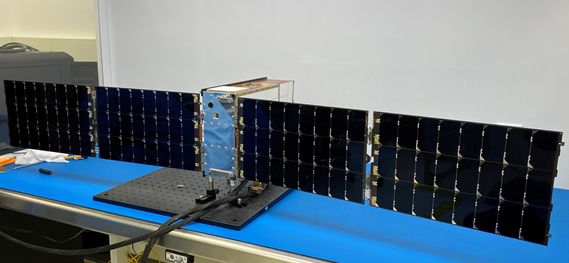SmallSat Missions @ GoddardpetitSat

petitSat is a GSFC 6U CubeSat led by Principal Investigator Dr. Jeffrey Klenzing. The mission is funded by the NASA Science Mission Directorate Heliophysics Division. It is a collaboration that includes Utah State University, Virginia Polytechnic Institute and State University, and Boston University. petitSat's primary goal is to study the link between Medium-Scale Traveling Ionosphere Disturbances (MSTIDS), also referred to as electrobouyancy waves, and plasma enhancements and determine conditions under which MSTIDS generate large plasma enhancements, which can interfere with radio waves used for communication and navigation. Recent observations from the C/NOFS satellite suggest that multiple mechanisms are responsible for forming plasma enhancements, with wave action in the thermosphere as a significant driver of the enhanced densities. Statistical analysis of enhancements observed from satellites resembles statistics of MSTIDS with respect to seasonal variability and solar activity. In order to investigate the link between these two phenomena, both in situ data of the plasma enhancement and remote data of the MSTID at the magnetic footprint are required. petitSat is designed to provide in situ measurements of the plasma density, 3D ion drift, as well as ion and neutral composition. The instrument suite includes a combined retarding potential analyzer and cross-track drift meter and a neutral spectrometer. It will provide comprehensive information about the fluctuations in plasma, as well as changes in the neutral profile.
The Ion-Neutral Mass Spectrometer (INMS) is an in-house development at GSFC and has previous flight heritage on the Dellingr mission. The petitSat version will include the addition of a filament ionizer to the ion chamber. The Gridded Retarding Ion Drift Sensor (GRIDS) was built by Utah State University and tested by Virginia Tech prior to delivery to GSFC. The spacecraft bus is comprised of several COTS components from vendors such as Hyperion (star tracker and GPS receiver), Sensonor (IMU), GOMSpace (fine sun sensor and magnetometer), CubeSpace (reaction wheel), Ibeos (EPS and batteries), Blue Canyon Technologies (solar arrays), and Vulcan Wireless (radio and antenna). The flight computer was developed by GSFC along with the necessary interface boards. The instrument and spacecraft bus were integrated and tested at GSFC. petitSat also incorporated a technology demonstration of an impulse control system utilizing ion thrusters that was developed internally at GSFC.

The petitSat spacecraft was ejected from the International Space Station on December 29, 2022. The commissioning team was unable to establish communication with the spacecraft and it re-entered in early April, 2023. A Failure Review Board was convened and determined the likely technical cause of the failure to be a mix of undetected degradation of battery performance during I&T and problematic autonomous recovery scheme. petitSat was a tremendous learning experience for everyone involved and helped to pave the way for the rest of the CubeSat missions at GSFC.


